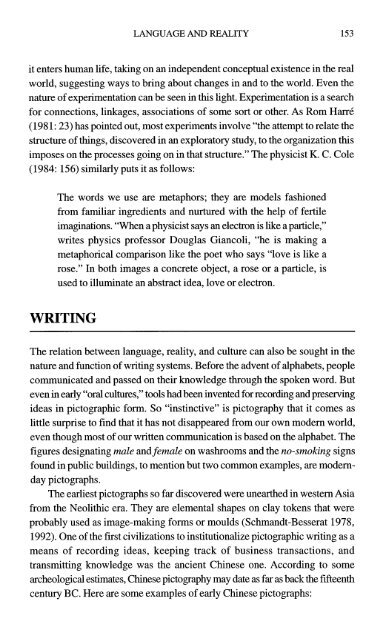A Basic Course in Anthropological Linguistics (Studies in Linguistic ...
A Basic Course in Anthropological Linguistics (Studies in Linguistic ...
A Basic Course in Anthropological Linguistics (Studies in Linguistic ...
Create successful ePaper yourself
Turn your PDF publications into a flip-book with our unique Google optimized e-Paper software.
LANGUAGE AND REALITY 153<br />
it enters human life, tak<strong>in</strong>g on an <strong>in</strong>dependent conceptual existence <strong>in</strong> the real<br />
world, suggest<strong>in</strong>g ways to br<strong>in</strong>g about changes <strong>in</strong> and to the world. Even the<br />
nature of experimentation can be seen <strong>in</strong> this light. Experimentation is a search<br />
for connections, l<strong>in</strong>kages, associations of some sort or other. As Rom Harr6<br />
(198 1 : 23) has po<strong>in</strong>ted out, most experiments <strong>in</strong>volve “the attempt to relate the<br />
structure of th<strong>in</strong>gs, discovered <strong>in</strong> an exploratory study, to the organization this<br />
imposes on the processes go<strong>in</strong>g on <strong>in</strong> that structure.” The physicist K. C. Cole<br />
(1984: 156) similarly puts it as follows:<br />
The words we use are metaphors; they are models fashioned<br />
from familiar <strong>in</strong>gredients and nurtured with the help of fertile<br />
imag<strong>in</strong>ations. “When a physicist says an electron is hke a particle,”<br />
writes physics professor Douglas Giancoli, “he is mak<strong>in</strong>g a<br />
metaphorical comparison like the poet who says “love is like a<br />
rose.” In both images a concrete object, a rose or a particle, is<br />
used to illum<strong>in</strong>ate an abstract idea, love or electron.<br />
WRITING<br />
The relation between language, reality, and culture can also be sought <strong>in</strong> the<br />
nature and function of writ<strong>in</strong>g systems. Before the advent of alphabets, people<br />
communicated and passed on their knowledge through the spoken word. But<br />
even <strong>in</strong> early “oral cultures,” tools had been <strong>in</strong>vented for record<strong>in</strong>g and preserv<strong>in</strong>g<br />
ideas <strong>in</strong> pictographic form. So “<strong>in</strong>st<strong>in</strong>ctive” is pictography that it comes as<br />
little surprise to f<strong>in</strong>d that it has not disappeared from our own modern world,<br />
even though most of our written communication is based on the alphabet. The<br />
figures designat<strong>in</strong>g mule and female on washrooms and the no-smok<strong>in</strong>g signs<br />
found <strong>in</strong> public build<strong>in</strong>gs, to mention but two common examples, are modern-<br />
day pictographs.<br />
The earliest pictographs so far discovered were unearthed <strong>in</strong> western Asia<br />
from the Neolithic era. They are elemental shapes on clay tokens that were<br />
probably used as image-mak<strong>in</strong>g forms or moulds (Schmandt-Besserat 1978,<br />
1992). One of the first civilizations to <strong>in</strong>stitutionalize pictographic writ<strong>in</strong>g as a<br />
means of record<strong>in</strong>g ideas, keep<strong>in</strong>g track of bus<strong>in</strong>ess transactions, and<br />
transmitt<strong>in</strong>g knowledge was the ancient Ch<strong>in</strong>ese one. Accord<strong>in</strong>g to some<br />
archeological estimates, Ch<strong>in</strong>ese pictography may date as far as back the fifteenth<br />
century BC. Here are some examples of early Ch<strong>in</strong>ese pictographs:






